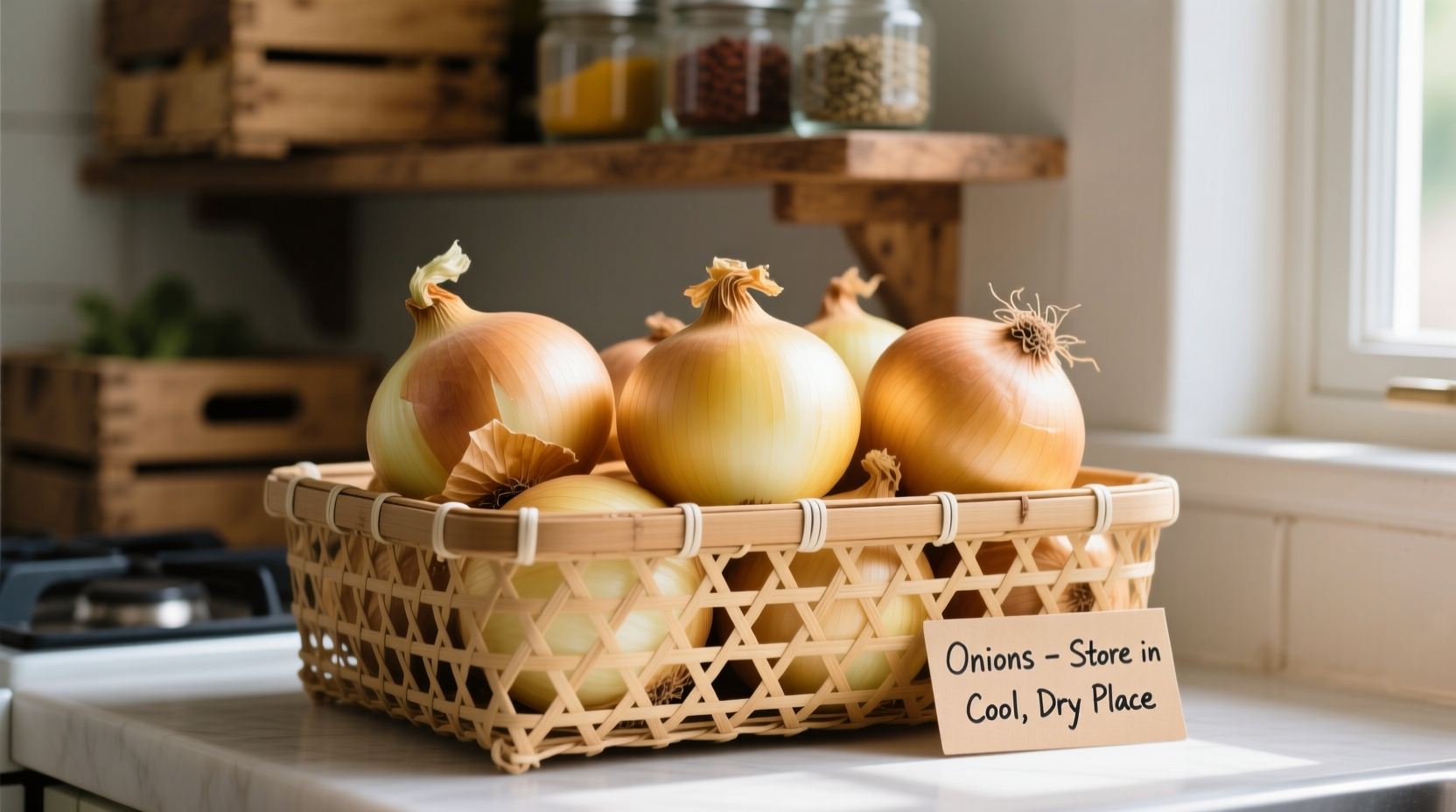Store whole onions in a cool (45-55°F/7-13°C), dry, dark place with good ventilation like a pantry or cellar. Keep them away from potatoes and moisture. Yellow onions last 2-3 months, red onions 1-2 months, and sweet onions 1-3 weeks when stored properly. Never refrigerate whole onions unless they're cut or sweet varieties.
Onions are kitchen staples that can quickly spoil if stored incorrectly, leading to wasted food and money. Proper storage extends their shelf life by 2-3 times while preserving flavor and texture. This guide reveals science-backed methods to keep your onions fresh longer, whether you're storing a single yellow onion or a bulk purchase from the farmers market.
Understanding Onion Types and Their Storage Needs
Not all onions store the same way. Each variety has unique characteristics that affect its shelf life and ideal storage conditions:
| Onion Type | Best Storage Method | Shelf Life | Special Considerations |
|---|---|---|---|
| Yellow/Brown | Cool, dark pantry | 2-3 months | Highest storage potential; keep away from moisture |
| Red/Purple | Cool, dark pantry | 1-2 months | Skin may fade over time but flavor remains |
| Sweet (Vidalia, Walla Walla) | Refrigerator | 1-3 weeks | Higher water content requires cooler temps |
| White | Cool, dark pantry | 1-2 months | More delicate skin than yellow onions |
| Shallots | Cool, dark pantry | 1-2 months | Store in mesh bags for best air circulation |
| Green Onions | Refrigerator in water | 1-2 weeks | Trim roots and change water every 2-3 days |
The Science Behind Proper Onion Storage
Understanding why certain storage methods work helps you adapt when ideal conditions aren't available. Onions continue to respire after harvest, releasing moisture and ethylene gas. The University of California's Postharvest Technology Center explains that proper storage slows this respiration process:
"Onions store best at 0-1°C (32-34°F) with 65-70% relative humidity. Higher humidity causes sprouting and decay, while temperatures above 70°F accelerate spoilage." (UC Davis Postharvest Technology Center)
Key factors affecting onion storage:
- Ventilation - Prevents moisture buildup that leads to mold
- Darkness - Light triggers sprouting in stored onions
- Separation from potatoes - Potatoes emit moisture and gases that shorten onion shelf life
- Dry conditions - Moisture is the primary cause of spoilage
Step-by-Step Storage Methods for Maximum Freshness
Storing Whole, Uncut Onions
Follow these steps for optimal pantry storage:
- Choose firm onions with dry, papery skins and no soft spots
- Cut away any green sprouts (they draw moisture from the bulb)
- Store in a mesh bag, basket, or open paper bag
- Place in a cool, dark location with good air circulation
- Check weekly for any softening or sprouting onions
Avoid storing whole onions in plastic bags, which trap moisture and accelerate spoilage. The USDA Food Safety and Inspection Service confirms: "Onions require good air circulation to maintain quality during storage." (USDA FSIS)

Storing Cut or Partially Used Onions
Once cut, onions require different handling:
- Place cut surfaces down on a clean plate
- Cover tightly with plastic wrap or place in an airtight container
- Store in the refrigerator's crisper drawer
- Use within 7-10 days for best quality
For sliced or diced onions, press plastic wrap directly against the surface before sealing the container to minimize oxidation. This technique preserves both flavor and texture significantly longer than standard storage methods.
Special Storage Situations
Sweet onions: Due to higher water content, refrigerate sweet onions immediately. Store in the crisper drawer in a paper bag with holes for ventilation.
Green onions: Trim roots, place upright in a glass with 1-2 inches of water, and cover loosely with a plastic bag. Change water every 2-3 days to maintain freshness for up to 2 weeks.
Long-term storage: For surplus onions, freeze chopped onions on a baking sheet, then transfer to freezer bags. Frozen onions work well in cooked dishes but lose crispness.
Common Onion Storage Mistakes to Avoid
Even small errors can dramatically reduce onion shelf life:
- Storing with potatoes - Creates a humid microclimate that causes onions to spoil faster
- Refrigerating whole storage onions - Causes moisture absorption and texture changes
- Washing before storage - Introduces excess moisture that promotes mold
- Using sealed plastic containers for whole onions - Traps ethylene gas and moisture
- Keeping in direct sunlight - Accelerates sprouting and quality loss
How to Tell If Onions Have Gone Bad
Recognize these signs of spoilage before using onions in your cooking:
- Texture changes: Soft, mushy spots or overall softness (except for sweet onions which are naturally softer)
- Visual cues: Dark patches, mold growth, or excessive sprouting
- Smell test: Sour or unpleasant odor (fresh onions have a clean, sharp scent)
- Interior quality: Brown or black rings when cut open
When in doubt, cut away small sections to check interior condition. Discard onions with significant mold growth or foul odors.
Troubleshooting Common Storage Problems
Sprouting Onions
If your onions begin sprouting:
- Remove sprouts immediately (they draw moisture from the bulb)
- Use sprouted onions first as their shelf life is significantly reduced
- Check storage conditions - light exposure or warm temperatures trigger sprouting
Mold Development
To address mold issues:
- Isolate affected onions immediately (mold spreads quickly)
- Clean storage area with vinegar solution to eliminate spores
- Increase ventilation in your storage location
- Ensure onions are completely dry before storing
Soft or Mushy Spots
Localized soft spots indicate moisture problems:
- Cut away affected areas plus 1 inch around the spot
- Use the onion immediately in cooking
- Review your storage method for excess humidity











 浙公网安备
33010002000092号
浙公网安备
33010002000092号 浙B2-20120091-4
浙B2-20120091-4